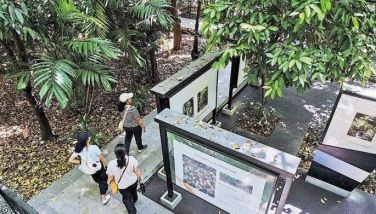Many Phl lakes dying
LOS BAÑOS, Laguna ,Philippines – Many of the country’s lakes are dying.
And it is just a matter of time before they meet their “ecological doom” if nothing is done now – and fast – to save them.
Not so few alarm bells have been pealed calling for the implementation of measures to stop their march toward total degradation.
Public outcry is high when fishkills take place, as what is now happening following the death of countless fish stocked in the 26,000-hectare Taal Lake, the country’s fourth largest body of inland water.
Yet it was not long ago (1993 and 2000) when “lake upturns” or “upwellings” made many fish cage operators much poorer in this Batangas lake of volcanic origin.
With the legendary “ningas cogon” mentality and complacency of national and local government officials and the private sector, lake upturns are certain to occur again in the future.
Just what is a lake upturn?
It is a natural phenomenon that takes place when the cooler mass of water at the surface is forced by winds to displace the warmer and oxygen-poor water mass in the bottom known as “hypolimnion,” explained the Los Baños-based Philippine Council for Aquatic and Marine Research and Development (PCAMRD).
The Department of Agriculture-Bureau of Fisheries and Aquatic Resources (DA-BFAR) has also pointed out that lake overturns usually occur during the cold months of December, January, and February owing to the northeast monsoon. Fishkills, though, also happen between April and August.
In another report, BFAR and the University of the Philippines Los Baños (UPLB) noted that during a wind-induced upturn, the surface water becomes acidic because of sulfur compounds brought up from the bottom and smells as asupre (sulfur).
Upturns have been taking place in lakes across the country, among them Lake Buhi in Camarines Sur, home to the endangered sinarapan, the world’s smallest extant commercial fish species; some of the seven lakes in San Pablo City (Laguna); Alligator Lake in Los Baños; and Lake Sebu in South Cotabato.
Fishkills have also time and again been reported in Laguna de Bay, the country’s largest (91,000-hectare) freshwater lake.
Lake upturns cannot be avoided as they naturally occur, explained PCAMRD, which, together with the UPLB-based Southeast Asian Ministers of Education Organization-Regional Center for Graduate Study and Research in Agriculture (SEAMEO SEARCA), jointly sponsored recently the Second National Congress on Philippine Lakes.
Held at SEARCA, LakeCon 2011 drew fishery scientists, policymakers, development managers, financing sources, and stakeholders to share their experiences and build consensus toward a common agenda for managing lake ecosystems.
Headed by Director Gil Saguiguit Jr., SEARCA is one of the 20 “centers of excellence” of SEAMEO, an inter-government treaty body founded in 1965 to foster cooperation among Southeast Asian nations in education, science, and culture.
Although lake upturn cannot be avoided as it occurs naturally, PCAMRD said fish cage farmers can minimize their losses by scaling down their operations during the cold months and refraining from overstocking and overfeeding so as not to increase the organic load in the lake bottom.
For instance, Lake Buhi in Buhi town, situated about 500 kilometers southeast of Manila, is choking in view of overstocking and overfeeding of tilapia.
The Philippine Fisheries Code of 1998 stipulates that fish cages should occupy only 10 percent of a lake’s total area to maintain its water quality and minimize pollution, but Lake Buhi had 15,597 fish cages occupying 70-80 percent of the 1,707-hectare lake, noted a 2006 study supported by SEARCA.
To maintain the fish stocks, cage operators used 2,840 tons of feeds every production cycle (about four months). The unused feeds that settled in the bottom aggravated the lake’s already grave pollution problems.
On July 15 last year, a massive fishkill again took place in Lake Buhi. Three months later (October), another fishkill occurred, killing about 100 tons of tilapia.
As the title of a science poster entered in the SEARCA/PCAMRD-sponsored LakeCon 2011 admonished: “Save Lake Buhi Now.”
San Pablo City, about 100 kilometers southeast of Manila, used to be vaunted as “the city of seven lakes.” It still is, but many of these once pristine lakes of volcanic origin are dying – and the time may not be far off when they will be nothing but murky and fetid ponds that have seen much better years.
- Latest
- Trending































